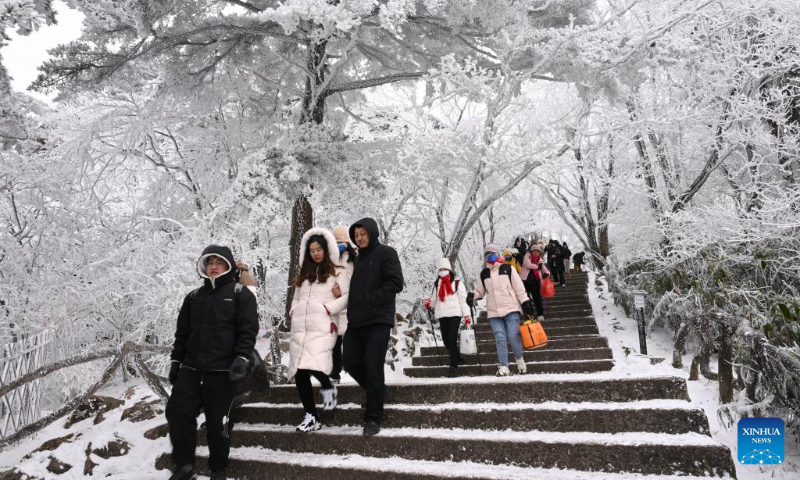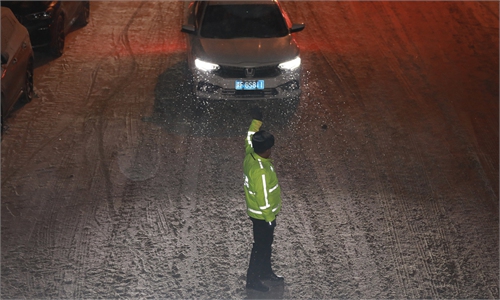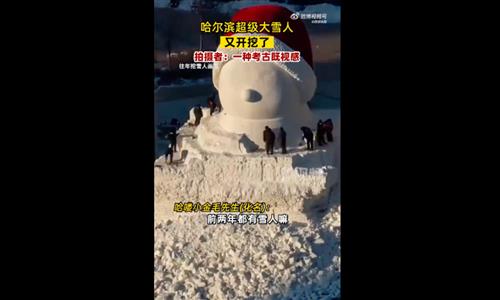Temperatures plunge to historic lows as severe cold fronts impact most of China
All-out efforts deployed to cope with extreme situations

Tourists enjoy the snow scenery at the Huangshan Mountain scenic area in Huangshan City, east China's Anhui Province, Dec. 16, 2023. The scenic area witnessed the first snowfall in this winter recently. (Xinhua/Zhou Mu)
Severe cold fronts have extended their grip over the majority of China, sending temperatures plunging below freezing and breaking historic extreme low records in multiple places, prompting authorities to deploy preventive arrangements to deal with possible extreme situations.
While experts reminded the public to take preventive measures to protect themselves as well as livestock as some places recorded temperatures below -40 C, they also assured the public there was no need to panic since China has strong capability to cope with extreme weather emergencies.
The past weekend was the coldest in the latter part of the year for a vast area of the country, with 23 provincial capital cities seeing record low temperatures since November, according to weather.com.cn.
The temperature difference between the highs and lows recorded at meteorological stations across China reached 76 C on Saturday, with the highest temperature of 31.8 C recorded in Baoting in South China's Hainan Province and the lowest of -44.2 C recorded in Tulihe township of Yakeshi city in North China's Inner Mongolia Autonomous Region.
A total of 30 national-level meteorological stations in multiple provinces and cities such as Hebei, Shanxi, Beijing, Tianjin and Liaoning, recorded historic extreme low temperatures for December on Sunday morning, with five stations in Shanxi, Hebei and Liaoning seeing new records since their establishment.
On Sunday, China's capital Beijing also suffered the coldest day of the winter season at -15.5 C. It was the third lowest temperature for the period since 1951, when China started collecting complete and continuous meteorological observation data.
As of 8 am in Beijing, 14 of 20 national meteorological stations saw new records for extreme low temperatures for mid-December.
Over the past few days, snowfalls have swept through the Taklimakan Desert, China's largest desert, in the Tarim Basin in Northwest China's Xinjiang Uygur Autonomous Region, covering the sand dunes under a "white coat."
Temperatures in some places in South China's Guangdong Province and Guangxi Zhuang Autonomous Region plunged 12 to 16 C in one day, leading to freezing rain and roads.
Affected by heavy snow, on Thursday evening, a subway train along the Changping Line in Beijing collided with the rear of a preceding train that had made an emergency stop, resulting in a separation of carriages, according to the preliminary investigation into the accident. A total of 102 people suffered fractures with no fatalities, authorities said on Friday.
In the wake of the accident, the national commission for disaster prevention, reduction and relief in a notification on Sunday urged authorities to strengthen patrols and control of key road sections, inspections of subways, overpasses, underpasses, and roads prone to freezing and accidents to effectively prevent accidents.
Ma Jun, director of the Beijing-based Institute of Public and Environmental Affairs, said that these cold waves have caused a vast area of snowfall, which will have a huge impact on the buildings, traffic and other infrastructure facilities that may affect the normal production and life orders in cities. Besides this, the snow can reflect sunlight and further slower warming during the day.
Especially in areas with extreme cold weather, such as in Inner Mongolia and Northeast China's Heilongjiang Province where temperatures below -40 C have been recorded, great caution should be taken to keep people and livestock warm and prevent damage from freezing, Ma told the Global Times on Sunday.
Chinese Vice Premier Zhang Guoqing, who is also director of the national commission for disaster prevention, reduction and relief, has required related departments to hold "red-line thinking" and "extreme thinking" to address possible extreme situations.
In a separate notification on Sunday, the commission called for all-out effort to be deployed to prevent and respond to low-temperature, rain, snow and freezing disasters. It emphasized that departments should establish complete emergency command systems to combat extreme weather, strengthen monitoring, warning, and analysis of weather patterns.
The commission said that there is an emergency dispatching mechanism for various energy sources to complement each other and carry out cross-provincial and cross-regional energy dispatching to ensure a steady and orderly supply and demand of energy across the country.
While the impact of this round of cold fronts has basically concluded, a new wave is predicted to sweep from the north toward the south from Monday to Wednesday that will affect the middle and eastern parts of the country, keeping the temperatures in the majority of the country at low levels next week, according to the China's National Meteorological Center (NMC).
It is expected that the lowest temperatures in Beijing will remain below -14 C through Thursday and that temperatures will remain below freezing throughout the following two weeks.
In Northeast China's Jilin Province, it is expected that temperatures in the eastern part of the province, the majority of Tonghua city, Baishan city, and Changbai Mountain National Nature Reserve will drop to -32 C, with some parts in the province even dropping to -35 C on Sunday and Monday.
Besides snow storms, the NMC has also forecast rainfall in multiple places, including the northern part of the Xinjiang region, the Jianghuai and Jiangnan regions and southern China.


